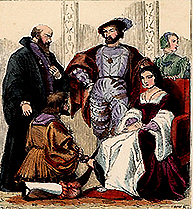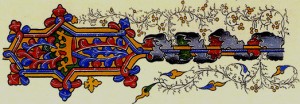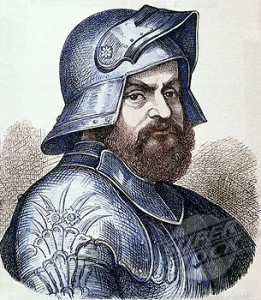Return to: Home > Historical Heritage Tours > Sir Walter Scott’s Marmion Tour > Full Itinerary Page
Tour Schedule
Day 1
Traveling from our hotel we begin out tour at Crichton Castle which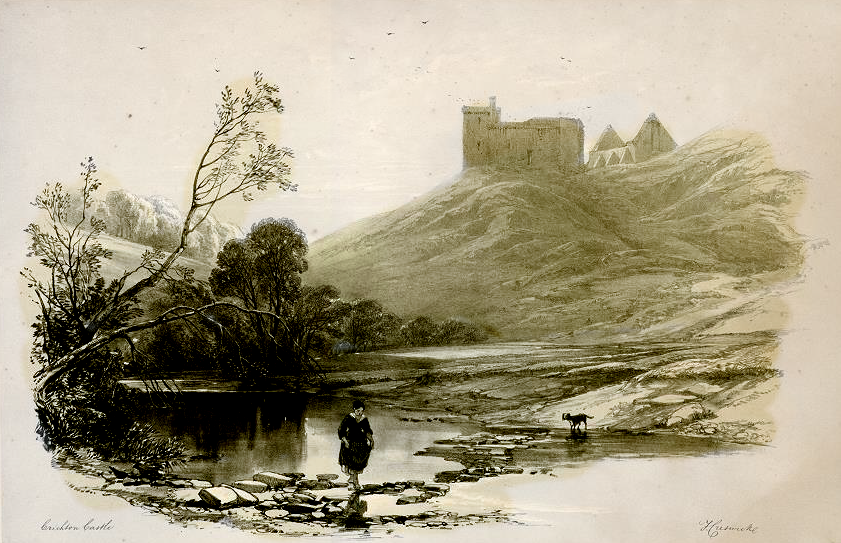 is located in a very picturesque location in a quiet and scenic valley of the River Tyne. Built as a baronial residence for the Earls of Crichton in the 14th Century, the castle developed and grew with the status of the family in the royal court when William Crichton became Sheriff of Edinburgh, keeper of Edinburgh Castle and Chancellor of Scotland during the reign of James II in 1437. However, the royal connection proved detrimental after Williams death, when his son and heir fell out of favour with the King and the family were disposed of their estate. The castle and the estate were granted instead to to Sir Patrick Hepburn who was also given the lordships of Bothwell beside the river Clyde and Crichton was elevated to a new Earldom of Bothwell. The Bothwells subsequently rose to be one of the most influential families in Scotland and Lord John Stewart, a half-brother of Mary Queen of Scots, married the 4th Earl’s sister in Crichton Castle, with the queen herself attending the ceremomy. In 1581 the 5th Earl of Bothwell extending and embellished the castle to create a Renaissance style mansion, incorporating features he had seen during his continental travels including the arcade of diamond-faceted stonework unique in Scotland.
is located in a very picturesque location in a quiet and scenic valley of the River Tyne. Built as a baronial residence for the Earls of Crichton in the 14th Century, the castle developed and grew with the status of the family in the royal court when William Crichton became Sheriff of Edinburgh, keeper of Edinburgh Castle and Chancellor of Scotland during the reign of James II in 1437. However, the royal connection proved detrimental after Williams death, when his son and heir fell out of favour with the King and the family were disposed of their estate. The castle and the estate were granted instead to to Sir Patrick Hepburn who was also given the lordships of Bothwell beside the river Clyde and Crichton was elevated to a new Earldom of Bothwell. The Bothwells subsequently rose to be one of the most influential families in Scotland and Lord John Stewart, a half-brother of Mary Queen of Scots, married the 4th Earl’s sister in Crichton Castle, with the queen herself attending the ceremomy. In 1581 the 5th Earl of Bothwell extending and embellished the castle to create a Renaissance style mansion, incorporating features he had seen during his continental travels including the arcade of diamond-faceted stonework unique in Scotland.
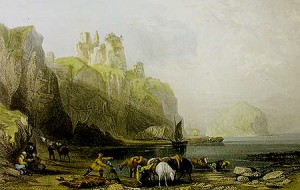 From Crichton we continue our journey along the Lothian coastline to visit one of the most picturesque located castles in Scotland. Built in the 15th century by the powerful Douglas family, Tantallon Castle occupies a spectacular and very scenic position on the seacliffs overlooking Bass Rock in the Firth of Forth. The clifftop position of the castle made it exceptionally difficult to attack and despite several sieges, remained in the ownership of the same family for many generations. It was besieged by King James IV in 1491, and again by his successor James V in 1528, when extensive damage was done to the structure. Tantallon saw action in the First Bishops’ War in 1639, and again during Oliver Cromwell’s invasion of Scotland in 1651, when it was once more severely damaged. Eventually fortified castles were no longer needed and it was sold by the Douglas family in 1699, and the ruin is today in the care of Historic Scotland.
From Crichton we continue our journey along the Lothian coastline to visit one of the most picturesque located castles in Scotland. Built in the 15th century by the powerful Douglas family, Tantallon Castle occupies a spectacular and very scenic position on the seacliffs overlooking Bass Rock in the Firth of Forth. The clifftop position of the castle made it exceptionally difficult to attack and despite several sieges, remained in the ownership of the same family for many generations. It was besieged by King James IV in 1491, and again by his successor James V in 1528, when extensive damage was done to the structure. Tantallon saw action in the First Bishops’ War in 1639, and again during Oliver Cromwell’s invasion of Scotland in 1651, when it was once more severely damaged. Eventually fortified castles were no longer needed and it was sold by the Douglas family in 1699, and the ruin is today in the care of Historic Scotland.
For lunch, we will visit one of the prettiest villages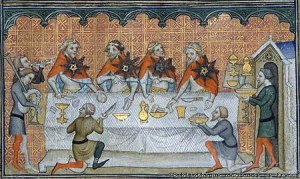 in Lowland Scotland. Gifford is a fine example of a “Model Village” built in the 17th century by the local laird, to replace an earlier settlement. It’s previous reincarnation of Yester grew up around Yester Castle and was the birth place of John Knox in 1505. As it was planned rather than developed over time, the village has a pleasant open aspect with a wide grass green to accommodate an annual fair and contains a multitude of interesting buildings. Gifford also has the noteriety of being the birthplace of John Witherspoon, who emigrated to North America to become one of the signatories of the American Declaration of Independence, and subsequently became the first president of Princeton University. The former hamlet of Yester is mentioned in the tale as a stop by Marmion’s party on its way to Edinburgh after crossing the Lammermuir Hills. In the story, the party take lunch at the village inn and we will enjoy a similar if less lordly feast.
in Lowland Scotland. Gifford is a fine example of a “Model Village” built in the 17th century by the local laird, to replace an earlier settlement. It’s previous reincarnation of Yester grew up around Yester Castle and was the birth place of John Knox in 1505. As it was planned rather than developed over time, the village has a pleasant open aspect with a wide grass green to accommodate an annual fair and contains a multitude of interesting buildings. Gifford also has the noteriety of being the birthplace of John Witherspoon, who emigrated to North America to become one of the signatories of the American Declaration of Independence, and subsequently became the first president of Princeton University. The former hamlet of Yester is mentioned in the tale as a stop by Marmion’s party on its way to Edinburgh after crossing the Lammermuir Hills. In the story, the party take lunch at the village inn and we will enjoy a similar if less lordly feast.
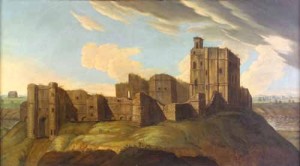 Crossing the River Tweed into Northumberland, England we visit the Border stronghold of Norham Castle. Majestically perched upon a steep bluff overlooking the river the site first became fortified in 1120 but was destroyed soon after by an invading army of Scots. In 1158 construction of a castle began by the Prince Bishop of Durham to secure his northern lands and in 1173 it was passed into control by King John of England. Owing to the position of the castle on the border between England and Scotland the building has been the subject of numerous sieges and phases of reconstruction and even in the ruinous state it is today has been the subject of numerous painters inspired by it’s impressive and dominant presence in the landscape of the Tweed Valley. Norham Castle has a close association with Sir William Marmion, who later became one of the many heroes of Flodden. Sir Walter Scott’s poem `Marmion’ has opening lines that feature Norham castle ;
Crossing the River Tweed into Northumberland, England we visit the Border stronghold of Norham Castle. Majestically perched upon a steep bluff overlooking the river the site first became fortified in 1120 but was destroyed soon after by an invading army of Scots. In 1158 construction of a castle began by the Prince Bishop of Durham to secure his northern lands and in 1173 it was passed into control by King John of England. Owing to the position of the castle on the border between England and Scotland the building has been the subject of numerous sieges and phases of reconstruction and even in the ruinous state it is today has been the subject of numerous painters inspired by it’s impressive and dominant presence in the landscape of the Tweed Valley. Norham Castle has a close association with Sir William Marmion, who later became one of the many heroes of Flodden. Sir Walter Scott’s poem `Marmion’ has opening lines that feature Norham castle ;
“Day set on Norham’s castled steep ,
And Tweed’s fair river, broad and deep,
And Cheviot’s mountain lone;
The battled towers, the Donjon keep,
The loophole grates where captives weep,
The flanking walls that round it sweep,
In yellow lustre shone.”
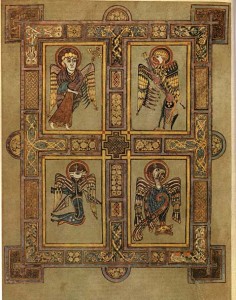 From Norham we travel to the beautiful and unspoilt Northumberland coastline to visit Holy Island or alternatively referred to as Lindesfarne. The picturesque Isle of Lindisfarne is situated off the coastline only a few miles south of the border with Scotland. The island is linked to the mainland by a causeway which twice a day is covered by the tide. The island has been a centre of Christian faith since 635 with building of the first monastery by Saint Aidan. Aidan and his monks came from the Irish monastery of Iona and with the support of Saxon King Oswald worked as missionaries among the English living in Northumbria. In their monastery they set up one of the first centres of learning in the British Isles. Lindisfarne became known for its skill in Christian art of which the Lindisfarne Gospels are the most important surviving example. Cuthbert became prior of Lindisfarne in 676. and during this period the monastary became known for its skill in producing illuminated books and the highly decorated Lindesfarne Gospels that were produced at this time, are still one of the most important articles of Christian heritage in Western Europe. Lindisfarne grew to became a great centre of pilgrimage and it was claimed was responsible for several miracles. Although today the priory is in ruins, Lindesfarne still retains a degree of spirituality and continues to be visited by both pilgrims and tourists alike.
From Norham we travel to the beautiful and unspoilt Northumberland coastline to visit Holy Island or alternatively referred to as Lindesfarne. The picturesque Isle of Lindisfarne is situated off the coastline only a few miles south of the border with Scotland. The island is linked to the mainland by a causeway which twice a day is covered by the tide. The island has been a centre of Christian faith since 635 with building of the first monastery by Saint Aidan. Aidan and his monks came from the Irish monastery of Iona and with the support of Saxon King Oswald worked as missionaries among the English living in Northumbria. In their monastery they set up one of the first centres of learning in the British Isles. Lindisfarne became known for its skill in Christian art of which the Lindisfarne Gospels are the most important surviving example. Cuthbert became prior of Lindisfarne in 676. and during this period the monastary became known for its skill in producing illuminated books and the highly decorated Lindesfarne Gospels that were produced at this time, are still one of the most important articles of Christian heritage in Western Europe. Lindisfarne grew to became a great centre of pilgrimage and it was claimed was responsible for several miracles. Although today the priory is in ruins, Lindesfarne still retains a degree of spirituality and continues to be visited by both pilgrims and tourists alike.
Day 2
We begin the morning by a visit to a castle which retains a considerable degree 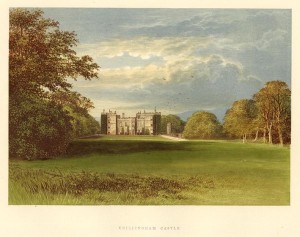 of medieval character. The site of Chillingham Castle was originally started as a Pele Tower and fortified Norman manor. It was made into a castle in the 13th Century by Sir Thomas Grey in 1344, when he was given permission to defend his property during the war between England and Scotland and erected a perimeter wall with four corner towers around his quadrangle and courtyard. The castle was besieged and taken by the Scottish army in 1513, when King James IV of Scotland spent his last night at the castle before his fatal battle on nearby Flodden Field. The castle reverted back to its pupose as a manor house after the union of the two crowns and during the 18th and 19th centuries saw decorative landscape refinements and extravagancies including gardens and grounds laid out by Sir Jeffrey Wyatville after undertaking similar improvements to Windsor Castle. However Chillingham is best known for the herd of wild cattle, which have inhabited its grounds for seven hundred years and are the purest surviving native wild white cattle in Britain a attributed to be descended from the British wild ox, which roamed the forested hills of northern Britain as early as the Bronze Age. Today the cattle can still be seen roaming the 365 acre walled parkland of the Chillingham estate.
of medieval character. The site of Chillingham Castle was originally started as a Pele Tower and fortified Norman manor. It was made into a castle in the 13th Century by Sir Thomas Grey in 1344, when he was given permission to defend his property during the war between England and Scotland and erected a perimeter wall with four corner towers around his quadrangle and courtyard. The castle was besieged and taken by the Scottish army in 1513, when King James IV of Scotland spent his last night at the castle before his fatal battle on nearby Flodden Field. The castle reverted back to its pupose as a manor house after the union of the two crowns and during the 18th and 19th centuries saw decorative landscape refinements and extravagancies including gardens and grounds laid out by Sir Jeffrey Wyatville after undertaking similar improvements to Windsor Castle. However Chillingham is best known for the herd of wild cattle, which have inhabited its grounds for seven hundred years and are the purest surviving native wild white cattle in Britain a attributed to be descended from the British wild ox, which roamed the forested hills of northern Britain as early as the Bronze Age. Today the cattle can still be seen roaming the 365 acre walled parkland of the Chillingham estate.
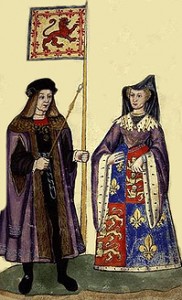 From Chillingham we make a short journey to the valley of the River Till and Etal Castle. Etal was built at a fording point of the River and like many in the borders started as a small manor but gradually evolved into a castle as fortifications were added to secure it from attack. In 1341, Robert was granted a licence to crenellate the property. He enclosed a square courtyard within curtain walls and added another storey with crenellations to the tower house. It took 15 years to fully strengthen the property. In the events leading up to the Battle of Flodden the Scottish King James IV captured the castle but after the defeat of the Scots the castle was restored to its owner and utilised to store captured equipment including canons. Today the Castle contains an award-winning exhibition which tells the story of the Battle of Flodden and warfare in the Borderlands.
From Chillingham we make a short journey to the valley of the River Till and Etal Castle. Etal was built at a fording point of the River and like many in the borders started as a small manor but gradually evolved into a castle as fortifications were added to secure it from attack. In 1341, Robert was granted a licence to crenellate the property. He enclosed a square courtyard within curtain walls and added another storey with crenellations to the tower house. It took 15 years to fully strengthen the property. In the events leading up to the Battle of Flodden the Scottish King James IV captured the castle but after the defeat of the Scots the castle was restored to its owner and utilised to store captured equipment including canons. Today the Castle contains an award-winning exhibition which tells the story of the Battle of Flodden and warfare in the Borderlands.
The Battle of Flodden Field in 1513 was one of the bloodiest and fateful battles in Scottish history. Here an invading Scottish army led by King James IV, succumbed to a devastating counter attack by the English which resulted in an estimated 10,000 fallen, amongst which were a large proportion of the Scottish nobility,  included twelve earls, fifteen lords, many clan chiefs an archbishop and above all King James himself. It is described as Britain’s last true Medieval battle and it was the first battle in the British Isles where artillery played a major part. From Etal we will travel a short distance to the battlefied site at Branxton Hill and after an illustrated talk on the events surrounding the battle, take some time to contemplate the fallen with a brief rendition of Sir Walter Scotts verses. (and the song “Flowers of the Forest” accompanied by a Scottish Piper, a particular touching and memorable part of the tour.) (Enjoy this YouTube link to the song “Flowers of the Forest” an emotional video of remembrance for fallen soldiers)
included twelve earls, fifteen lords, many clan chiefs an archbishop and above all King James himself. It is described as Britain’s last true Medieval battle and it was the first battle in the British Isles where artillery played a major part. From Etal we will travel a short distance to the battlefied site at Branxton Hill and after an illustrated talk on the events surrounding the battle, take some time to contemplate the fallen with a brief rendition of Sir Walter Scotts verses. (and the song “Flowers of the Forest” accompanied by a Scottish Piper, a particular touching and memorable part of the tour.) (Enjoy this YouTube link to the song “Flowers of the Forest” an emotional video of remembrance for fallen soldiers)
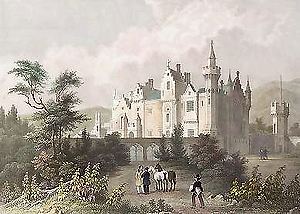 We continue the journey to follow the route of the retreating Scottish army back into Scotland and on to Sir Walter Scott’s home at Abbotsford. This large Victorian house in the Scottish baronial style is situated in the heart of the Scottish Borders and was completed in 1824. William Atkinson was the chosen architect, and George Bulloch gave his advice on the furnishings which reflect Scott’s historical interest, while local craftsmen carried out nearly all of the work. The house was opened to the public in 1833, five months after Sir Walter’s death, and has been enjoyed by visitors ever since. There is an impressive collection of historic relics, weapons and armour, (also Rob Roy’s Gun and Montrose’s Sword), and a library containing over 9,000 rare volumes. Visitors will be able to see Sir Walter Scott’s Study, Library, Drawing Room, Entrance Hall, Armouries and the Dining Room where he died on 21st September 1832. We will also take time to see the lovely walled garden with beautiful herbaceous borders and take in the lovely views along the River Tweed which Scott loved so dearly.
We continue the journey to follow the route of the retreating Scottish army back into Scotland and on to Sir Walter Scott’s home at Abbotsford. This large Victorian house in the Scottish baronial style is situated in the heart of the Scottish Borders and was completed in 1824. William Atkinson was the chosen architect, and George Bulloch gave his advice on the furnishings which reflect Scott’s historical interest, while local craftsmen carried out nearly all of the work. The house was opened to the public in 1833, five months after Sir Walter’s death, and has been enjoyed by visitors ever since. There is an impressive collection of historic relics, weapons and armour, (also Rob Roy’s Gun and Montrose’s Sword), and a library containing over 9,000 rare volumes. Visitors will be able to see Sir Walter Scott’s Study, Library, Drawing Room, Entrance Hall, Armouries and the Dining Room where he died on 21st September 1832. We will also take time to see the lovely walled garden with beautiful herbaceous borders and take in the lovely views along the River Tweed which Scott loved so dearly.
Our last visit of the day will be to Sir Walter’s last resting place at Dryburgh Abbey. Situated in a loop of the River Tweed, the abbey was founded in 1152 by Hugh de Morville, Lord of Lauderdale and was extended throught the Medieval period. In 1322 a retreating English army burned the building substantially and was completely rebuilt only to meet the same fate again in 1544 by another army. This and the onset of the Reformation resulted in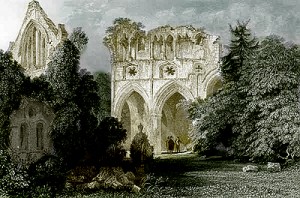 a substantial deminishment of the building’s role as a monasatary and by 1600 it had become entirely redundant. In 1786 the abandoned ruins were purchased by The Earl of Buchan who ensured its preservation whilst also undertaking his own improvements including the laying of a formal garden. This special place in Border history was very dear to Sir Walter Scott’s heart and upon his death the Earl gave special dispensation fot this great Scottish writer to be laid to rest there along with his family in his honour. It is therefore a fitting place to pay our respects to the author and read some of the last verses of the ballad of Marmion.
a substantial deminishment of the building’s role as a monasatary and by 1600 it had become entirely redundant. In 1786 the abandoned ruins were purchased by The Earl of Buchan who ensured its preservation whilst also undertaking his own improvements including the laying of a formal garden. This special place in Border history was very dear to Sir Walter Scott’s heart and upon his death the Earl gave special dispensation fot this great Scottish writer to be laid to rest there along with his family in his honour. It is therefore a fitting place to pay our respects to the author and read some of the last verses of the ballad of Marmion.





